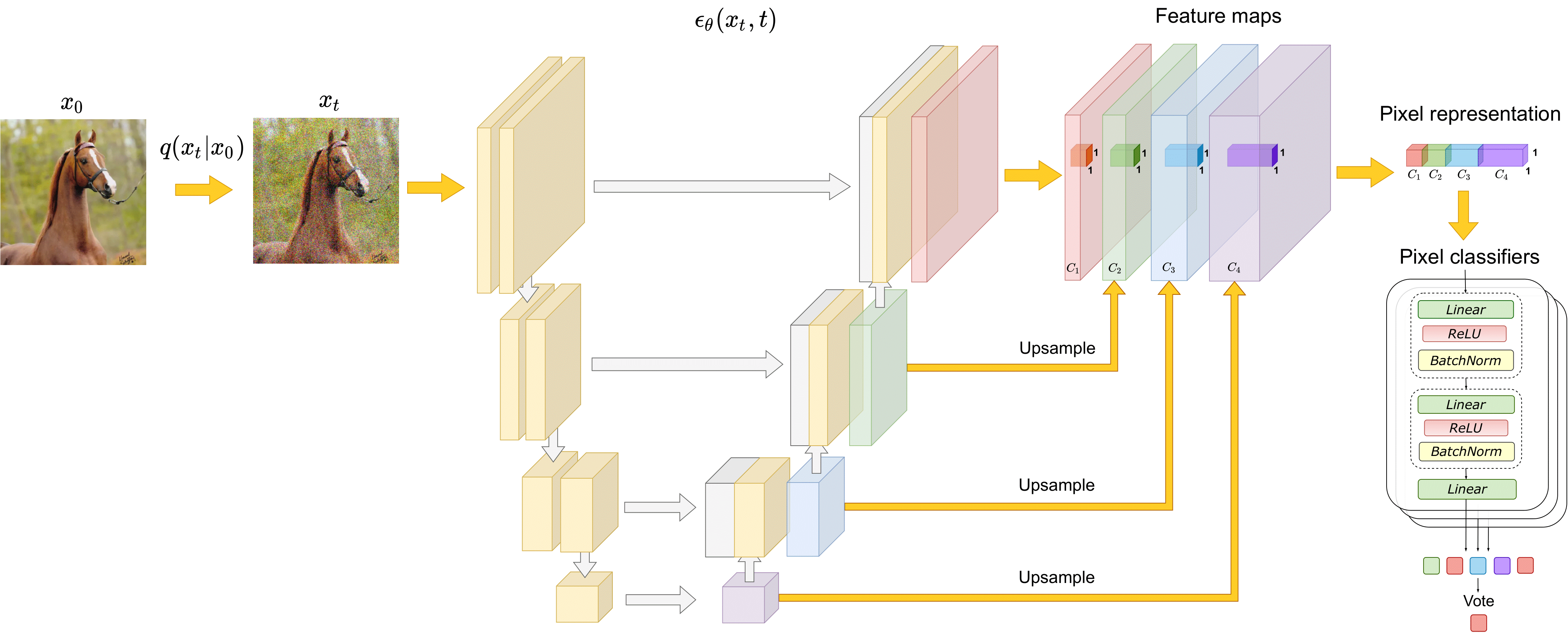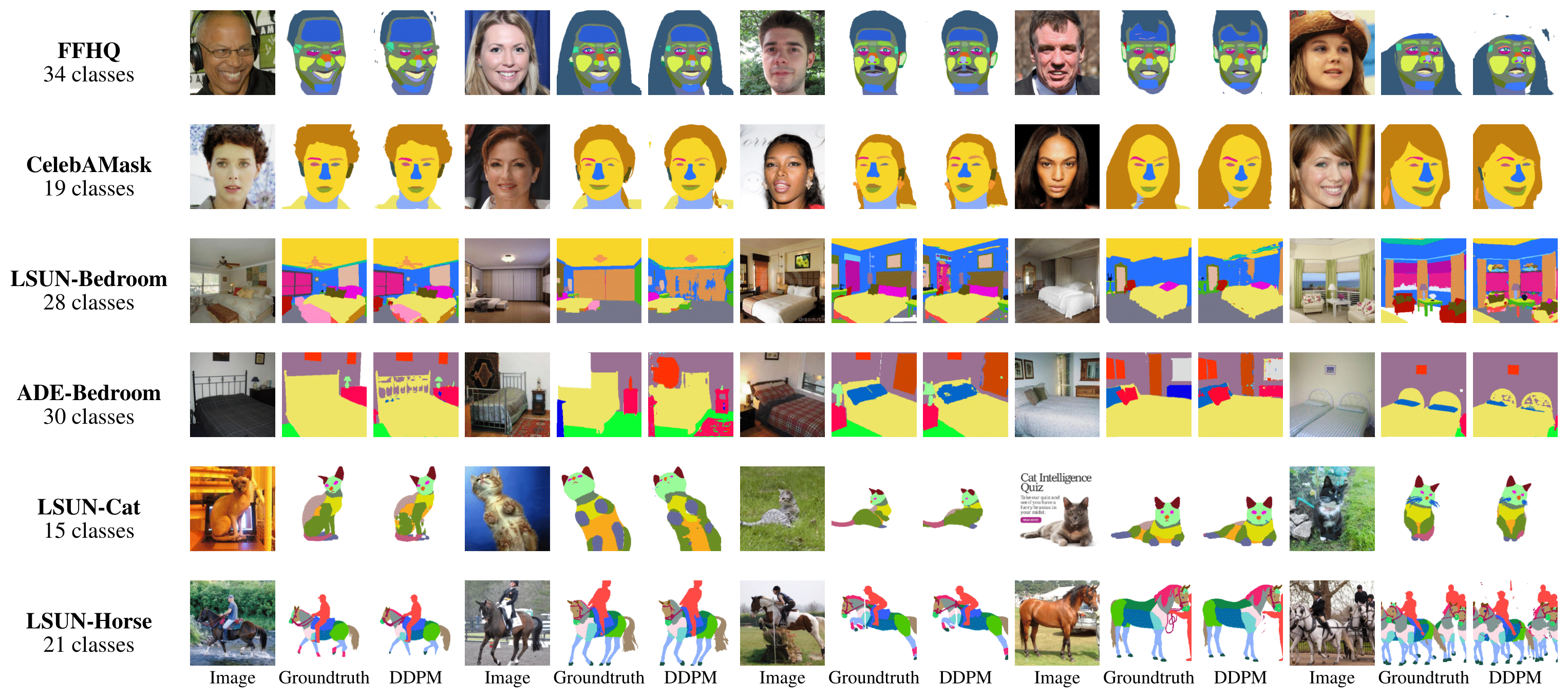Label-Efficient Semantic Segmentation with Diffusion Models
Official implementation of the paper Label-Efficient Semantic Segmentation with Diffusion Models
This code is based on datasetGAN and guided-diffusion.
Note: use --recurse-submodules when clone.
Overview
The paper investigates the representations learned by the state-of-the-art DDPMs and shows that they capture high-level semantic information valuable for downstream vision tasks. We design a simple segmentation approach that exploits these representations and outperforms the alternatives in the few-shot operating point in the context of semantic segmentation.
Dependencies
- Python >= 3.7
- Packages: see
requirements.txt
Datasets
The evaluation is performed on 6 collected datasets with a few annotated images in the training set: Bedroom-18, FFHQ-34, Cat-15, Horse-21, CelebA-19 and ADE-Bedroom-30. The number corresponds to the number of semantic classes.
datasets.tar.gz (~47Mb)
DDPM
Pretrained DDPMs
The models trained on LSUN are adopted from guided-diffusion. FFHQ-256 is trained by ourselves using the same model parameters as for the LSUN models.
LSUN-Bedroom: lsun_bedroom.pt
FFHQ-256: ffhq.pt
LSUN-Cat: lsun_cat.pt
LSUN-Horse: lsun_horse.pt
Run
- Download the datasets:
bash datasets/download_datasets.sh - Download the DDPM checkpoint:
bash checkpoints/ddpm/download_checkpoint.sh - Check paths in
experiments//ddpm.json - Run:
bash scripts/ddpm/train_interpreter.sh
Available checkpoint names: lsun_bedroom, ffhq, lsun_cat, lsun_horse
Available dataset names: bedroom_28, ffhq_34, cat_15, horse_21, celeba_19, ade_bedroom_30
How to improve the performance
- Set input_activations=true in
experiments/./ddpm.json
In this case, the feature dimension is 18432. - Tune for a particular task what diffusion steps and UNet blocks to use.
DatasetDDPM
Synthetic datasets
To download DDPM-produced synthetic datasets (50000 samples, ~7Gb):
bash synthetic-datasets/gan/download_synthetic_dataset.sh
Run | Option #1
- Download the synthetic dataset:
bash synthetic-datasets/ddpm/download_synthetic_dataset.sh - Check paths in
experiments//datasetDDPM.json - Run:
bash scripts/datasetDDPM/train_deeplab.sh
Run | Option #2
-
Download the datasets:
bash datasets/download_datasets.sh -
Download the DDPM checkpoint:
bash checkpoints/ddpm/download_checkpoint.sh -
Check paths in
experiments//datasetDDPM.json -
Train an interpreter on a few DDPM-produced annotated samples:
bash scripts/datasetDDPM/train_interpreter.sh -
Generate a synthetic dataset:
bash scripts/datasetDDPM/generate_dataset.sh
Please specify the hyperparameters in this script for the available resources.
On 8xA100 80Gb, it takes about 12 hours to generate 10000 samples. -
Run:
bash scripts/datasetDDPM/train_deeplab.sh
One needs to specify the path to the generated data. See comments in the script.
Available checkpoint names: lsun_bedroom, ffhq, lsun_cat, lsun_horse
Available dataset names: bedroom_28, ffhq_34, cat_15, horse_21
SwAV
Pretrained SwAVs
We pretrain SwAV models using the official implementation on the LSUN and FFHQ-256 datasets:
LSUN-Bedroom: lsun_bedroom.pth
FFHQ-256: ffhq.pth
LSUN-Cat: lsun_cat.pth
LSUN-Horse: lsun_horse.pth
Training setup:
| Dataset | epochs | batch-size | multi-crop | num-prototypes |
|---|---|---|---|---|
| LSUN | 200 | 1792 | 2x256 + 6x108 | 1000 |
| FFHQ-256 | 400 | 2048 | 2x224 + 6x96 | 200 |
Run
- Download the datasets:
bash datasets/download_datasets.sh - Download the SwAV checkpoint:
bash checkpoints/swav/download_checkpoint.sh - Check paths in
experiments//swav.json - Run:
bash scripts/swav/train_interpreter.sh
Available checkpoint names: lsun_bedroom, ffhq, lsun_cat, lsun_horse
Available dataset names: bedroom_28, ffhq_34, cat_15, horse_21, celeba_19, ade_bedroom_30
DatasetGAN
Opposed to the official implementation, more recent StyleGAN2(-ADA) models are used.
Synthetic datasets
To download GAN-produced synthetic datasets (50000 samples):
bash synthetic-datasets/gan/download_synthetic_dataset.sh
Run
Since we almost fully adopt the official implementation, we don't provide our reimplementation here. However, one can still reproduce our results:
- Download the synthetic dataset:
bash synthetic-datasets/gan/download_synthetic_dataset.sh - Change paths in
experiments//datasetDDPM.json - Change paths and run:
bash scripts/datasetDDPM/train_deeplab.sh
Available dataset names: bedroom_28, ffhq_34, cat_15, horse_21
Results
- Performance in terms of mean IoU:
| Method | Bedroom-28 | FFHQ-34 | Cat-15 | Horse-21 | CelebA-19 | ADE-Bedroom-30 |
|---|---|---|---|---|---|---|
| ALAE | 20.0 ± 1.0 | 48.1 ± 1.3 | -- | -- | 49.7 ± 0.7 | 15.0 ± 0.5 |
| VDVAE | -- | 57.3 ± 1.1 | -- | -- | 54.1 ± 1.0 | -- |
| GAN Inversion | 13.9 ± 0.6 | 51.7 ± 0.8 | 21.4 ± 1.7 | 17.7 ± 0.4 | 51.5 ± 2.3 | 11.1 ± 0.2 |
| GAN Encoder | 22.4 ± 1.6 | 53.9 ± 1.3 | 32.0 ± 1.8 | 26.7 ± 0.7 | 53.9 ± 0.8 | 15.7 ± 0.3 |
| SwAV | 41.0 ± 2.3 | 54.7 ± 1.4 | 44.1 ± 2.1 | 51.7 ± 0.5 | 53.2 ± 1.0 | 30.3 ± 1.5 |
| DatasetGAN | 31.3 ± 2.7 | 57.0 ± 1.0 | 36.5 ± 2.3 | 45.4 ± 1.4 | -- | -- |
| DatasetDDPM | 46.9 ± 2.8 | 56.0 ± 0.9 | 45.4 ± 2.8 | 60.4 ± 1.2 | -- | -- |
| DDPM | 46.1 ± 1.9 | 57.0 ± 1.4 | 52.3 ± 3.0 | 63.1 ± 0.9 | 57.0 ± 1.0 | 32.3 ± 1.5 |
- Examples of segmentation masks predicted by the DDPM-based method:
Cite
@misc{baranchuk2021labelefficient,
title={Label-Efficient Semantic Segmentation with Diffusion Models},
author={Dmitry Baranchuk and Ivan Rubachev and Andrey Voynov and Valentin Khrulkov and Artem Babenko},
year={2021},
eprint={2112.03126},
archivePrefix={arXiv},
primaryClass={cs.CV}
}

